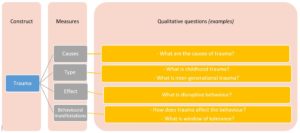
Gathering data is the most crucial part whether in research or evaluation projects. Once the investigator knows what the research question is, the next important factor is to identify the determine the research approach and then select the population and sample of the study. Choosing the correct sampling technique is absolutely vital and determines the success or failure of a research or evaluation project. Because, sampling the wrong subject will not provide the correct information as it is intended by the research or evaluation question. In general terms, sampling is the process of identifying the representative group of subjects from the population. The word population in the realm of research denotes the total group of subjects identified in a study. The selected group of samples are usually known as ‘Participants’ or ‘Respondents’. In this article, we will share the various sampling techniques with some examples.
All the sampling techniques are divided into two categories – Probability sampling and non-probability sampling.
Probability Sampling Methods
Simple random sampling
This sampling method is based on probability. In this technique each individual is chosen entirely by random choice by the researcher. Each individual of the population has an equal chance, or probability, of being selected as the participant in the study. One way of obtaining a random sample is to give each individual in a population a number, and then use a table of random numbers to decide which individuals to include.
Example –
In a research study with a population size of 200, the researcher may assign a label of 0 to 200 and then decide to select those with an odd number. Thus, only the samples with odd number will be selected. This could be further randomised based on the specific numbers such odd numbers with only having 7 or 9 will be selected. Thus the researcher can ensure that the sample process is entirely random and there is no bias in the way the participants are selected.
Systematic sampling
This technique is also random but done through maintaining a system or formula. The subjects could be selected at regular intervals from the entire population. The intervals are chosen to ensure an adequate sample size. If you need a sample size n from a population of size x, you should select every x/nth individual for the sample.
Example –
In a population of 500 samples, the researcher might decide to select 50 samples. In that case the researcher will use this formula = x/nth individual for the sample. 500/50 = 10th member of the population. Systematic sampling is often more convenient than simple random sampling, and it is easy to administer.
Stratified sampling
Stratified sampling is another probability sampling technique where the population is viewed in this method, the population is first divided into subgroups (or strata) who all share a similar characteristic.
Example –
In a study of the health outcomes of nursing staff in a county, if there are three hospitals each with different numbers of nursing staff (hospital A has 500 nurses, hospital B has 1000 and hospital C has 2000), then it would be appropriate to choose the sample numbers from each hospital proportionally (e.g. 10 from hospital A, 20 from hospital B and 40 from hospital C). This ensures a more realistic and accurate estimation of the health outcomes of nurses across the county.
Clustered sampling
In a clustered sample, subgroups of the population are used as the sampling unit, rather than individuals. The population is divided into subgroups, known as clusters, which are randomly selected to be included in the study. Cluster sampling falls into two different categories – single-stage cluster and two-stage cluster.
Example –
Individual GP practices or districts could be identified as clusters. In single-stage cluster sampling, all members of the chosen clusters are then included in the study. In two-stage cluster sampling, a selection of individuals from each cluster is randomly selected for inclusion.
Non-Probability Sampling Methods
Convenience sampling
Convenience sampling is one of the easiest sampling techniques. The researcher in this sampling technique choses the participants based on their availability and willingness to take part in the research. Since the sampling process is entirely dependent on the researcher’s discretion but so there always remains a potential for bias.
Example –
In a study to assess the perception and motivation of startup founders on why they started their venture, the investigator may select the one’s who will be accessible and are agreed to take part in the study.
Quota sampling
In this technique, the participants are chosen based on a predetermined quota falling under a specific category. This technique is quite popular in market research agencies. Interviewers are given a quota of subjects of a specified type to attempt to recruit.
Example-
An interviewer might be told to go out and select 10 adult male, 10 adult female, 5 teenage girls and 5 teenage boys to interview them about their smart phone usage behaviour. The quotas are chosen proportionally to represent the characteristics of the underlying population.
Purposive Sampling
A non-probability sampling technique, purposive sampling technique is also known as selective or subjective sampling technique. Purposive sampling is determined by the researcher’s own judgement based on the preliminary insight gathered from the research topic.
Example –
In a research which aims to ascertain the number of patients who are covID-19 positive in a specific suburb, the investigator may choose to select the one’s who are closely located to his/her location. The investigator may have other considering factors based upon which he/she will select the final samples.
- Snowball sampling
Snowball sampling is a non-probability sampling technique. When the participants in a study are difficult to source, snowball sampling method is used. In this technique, the existing participants are asked to nominate further participants, so the sample size increases in size like a rolling snowball which picks up more snow along the way. Snowball sampling can be effective when a sampling frame is difficult to identify. However, by selecting friends and acquaintances of subjects already investigated, there is a significant risk of selection bias
Example –
When carrying out a survey of risk behaviours amongst drug addicts, participants may be asked to nominate other drug addicts who are known to them. In this case the drug addicts will select the sample.
Sampling bias –
One of the obvious inhibitors of good sampling practice is the bias from the investigator in the way he/she nominates the final group of participants. Often times the investigator are influenced by a range of factors some of which are in control and some may not be in control. Typically, the following scenarios may give rise to sampling bias –
- Lower response rate or hard to reach population
- Using out-of-date sampling list
- Having no pre-agreed sampling technique
- Lower response rate
- Favouritism by the investigator
References
- https://www.healthknowledge.org.uk/public-health-textbook/research-methods/1a-epidemiology/methods-of-sampling-population










